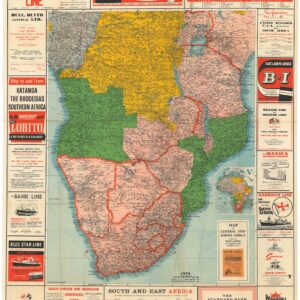Marvelous piece of Victorian mapmaking commemorating the General Gordon’s exploits at the Siege of Khartoum
Birds Eye View of the Soudan and Surrounding Countries
Out of stock
Description
This is a splendid bird’s-eye-view of Northeast Africa, including Sudan, Ethiopia, and Eritrea. The mapmaker uses detailed shading and coloring to depict the varied topography, including mountains, rivers, and deserts. A table in the bottom margin lists distances from Cairo in stages to Khartoum.
The map has two inset vignettes: at upper left, views of Khartoum and surroundings; at upper right, two large portraits of General Gordon and Colonel Stewart.
The is clearly design to satisfy a British public eager for information regarding the famous and controversial General Gordon, a larger-than-life figure who might be described as the quintessential Victorian army man.
Major-General Charles George Gordon CB (28 January 1833 – 26 January 1885), also known as Chinese Gordon, Gordon Pasha, and Gordon of Khartoum, was a British Army officer and administrator. He saw action in the Crimean War as an officer in the British Army. However, he made his military reputation in China, where he was placed in command of the “Ever Victorious Army,” a force of Chinese soldiers led by European officers. In the early 1860s, Gordon and his men were instrumental in putting down the Taiping Rebellion, regularly defeating much larger forces. For these accomplishments, he was given the nickname “Chinese Gordon” and honors from both the Emperor of China and the British.
He entered the service of the Khedive of Egypt in 1873 (with British government approval) and later became the Governor-General of the Sudan, where he did much to suppress revolts and the local slave trade. Exhausted, he resigned and returned to Europe in 1880.
A serious revolt then broke out in the Sudan, led by a Muslim religious leader and self-proclaimed Mahdi, Muhammad Ahmad. In early 1884 Gordon had been sent to Khartoum with instructions to secure the evacuation of loyal soldiers and civilians and to depart with them. In defiance of those instructions, after evacuating about 2,500 civilians he retained a smaller group of soldiers and non-military men. In the buildup to battle, the two leaders corresponded, each attempting to convert the other to his faith, but neither would accede.
Besieged by the Mahdi’s forces, Gordon organized a citywide defense lasting almost a year that gained him the admiration of the British public, but not of the government, which had wished him not to become entrenched. Only when public pressure to act had become irresistible did the government, with reluctance, send a relief force. It arrived two days after the city had fallen and Gordon had been killed.
Cartographer(s):
Condition Description
Excellent image. Trimmed along bottom.
References




![[South Africa] Photograph panorama of Cape Town, c. 1870](https://neatlinemaps.com/wp-content/uploads/2022/09/Screen-Shot-2022-12-18-at-11.22.15-AM-300x300.png)